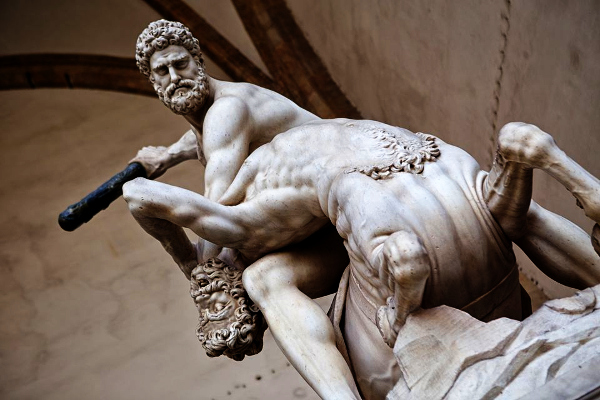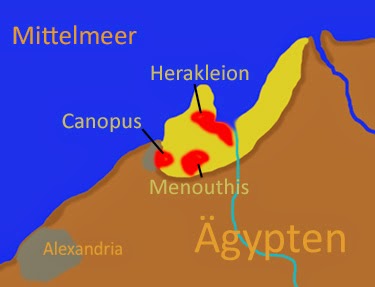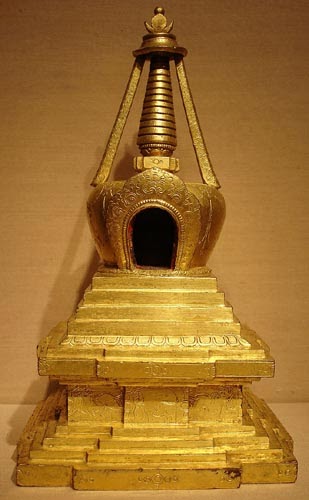In a previous article titled “Hercules and Balarama: The Symbolic and Historical Connections” I had pointed out that the statements of the Greek historians such as Arrian and Diodorus Siculus (who were quoting from the still earlier works of Megasthenes), indicate that the Grecian Hercules was Balarama, the elder brother of Krishna. A number of Oriental scholars, including Captain Francis Wilford and Colonel James Tod have provided further insights in support of this association, while my own research has led me to identify some more commonalities between these heroic personalities.
Both Hercules and Balarama were known to be strong and courageous individuals who had rid the world of monsters. They shared common epithets, and were depicted in art and sculpture holding various implements such as the club, plough, lion’s skin, wine-cup, bow and arrow, sword etc. The labors of Hercules and the exploits of the Indian brother deities Krishna-Balarama also share a number of symbolic elements – the multi-headed serpent, the ferocious bull, the man-eating birds, the fire-breathing horses, amongst many others – which suggest that these stories sprang from a common source. Since the ancient Greeks, who were referred to as the Yavanas or Yonas in the Sanskrit texts, had taken part in the Mahabharata War (which took place at around c.4000 BC, using the Saptarshi Calendar as the basis of the Yuga Cycle), and many Greek colonies also existed within India during this epoch, it appears eminently possible that the Greeks had idolized Balarama for his heroic exploits, and turned him into their cultural hero.
However, one important question was not addressed in the previous article; and that is the identity of the Theban Hercules.
Arrian (who was quoting from the works of Megasthenes and Nearchus) had made an intriguing comment about the Indian Hercules i.e. Balarama. He said: “The Hercules who penetrated so far, the Indians tell us, was a native of their country…This Hercules, as Megasthenes asserts, and the Indians themselves assure us, uses the same habit with the Theban Hercules.”
But who was this Theban Hercules? We do not find any mention of Hercules in the ancient Egyptian texts. And yet, this statement of Arrian suggests that there was a Hercules in Egypt as well, who was venerated at the ancient city of Thebes. How do we ascertain the identity of this deity?
The Theban Hercules
Fortunately, Herodotus (c. 484–425 BC) had written of the Theban Hercules during his travels to Egypt. He says that the “Egyptian Hercules is one of their ancient gods”. He was one of the twelve secondary gods who were produced from the eight original gods. He also noted that the Egyptians, who live in Thebes and worship Amun, depict Amun with the face of a “ram”, since this was the form in which he had revealed himself to Hercules:
“Hercules,” they say, “wished of all things to see Jove (Amun), but Jove didn’t choose to be seen of him. At length, when Hercules persisted, Jove hit on a device – to flay a ram, and, cutting off his head, hold the head before him, and cover himself with the fleece. In this guise he showed himself to Hercules…Such, then, is the reason why the Thebans don’t sacrifice rams, but consider them sacred animals.
On one day in the year, however, at the festival of Jupiter (Amun), they slay a single ram, and stripping off the fleece, cover with it the statue of that god, as he once covered himself, and then bring up to the statue of Jove an image of Hercules. When this has been done, the whole assembly beat their breasts in mourning for the ram, and afterwards buries him in a holy sepulchre.”
The yearly festival of Amun mentioned by Herodotus is the annual Opet festival of Thebes, in which the idols of the Theban triad of divinities – Amun, Khonsu, and Mut – were carried on sacred barques from Karnak to Luxor with much fanfare and rejoicing. Since the Theban Hercules was an integral part of the Opet festival, as mentioned by Herodotus, it implies that the lunar-god Khonsu, the only other male deity of the Theban triad, must have been the Theban Hercules.
There was, in fact, an ancient Greek tradition which identified Hercules with Khonsu, and Herodotus had also referred to Khonsu as Heracles-Khonsu. Herodotus mentioned that he had visited the temple of Heracles in the ancient Egyptian port city of Heracleion, located near the Canopic mouth of the Nile, close to Alexandria. This great temple had been built where Heracles had first set foot on Egypt. The temple had been visited by Helena and Paris before the Trojan War, as they fled the fury of Helena’s husband Menelaus. More than four centuries after Herodotus’ visit to Egypt in the 5th century BC, the Greek geographer Strabo had observed that the city of Heracleion, which possessed the temple of Heracles, was located straight to the east of Canopus at the mouth of the Canopic branch of the River Nile.
Heracleion (also known as Thonis) had reached its peak around the 6th – 4th century BC, when it was the primary port of entry to Egypt for all ships coming from the Greek world. However, sometime in the 8th century AD, the entire city sunk into the ocean due to floods and earthquakes. In 2001, the French marine archeologist Frank Goddio discovered the submerged ruins of Heracleion in the Abu Qir Bay, nearly 6.5 kms. off the coast. They found a temple complex dedicated to Amun and to Heracles-Khonsu, and among the many fascinating sculptures and inscriptions recovered, was an imposing shrine in pink granite, which belonged to the temple of Heracles-Khonsu.
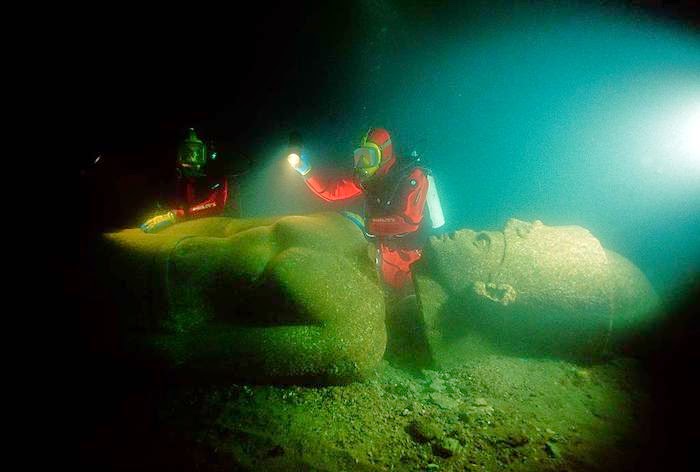
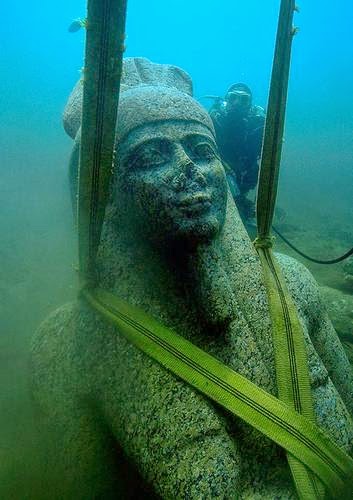
It is evident that the Greek tradition of identifying Hercules with Khonsu has been validated by the archaeological discoveries made off the coast of Alexandria.But, we are still left to wonder why Arrian had said that the Indian Hercules i.e. Balarama “uses the same habit with the Theban Hercules”. Are there any obvious symbolic connections between Khonsu and Balarama which would support this contention? In order to find that out, let us look at a brief comparison of the epithets and iconography of Khonsu with those of Balarama.
The Iconography of Heracles-Khonsu
The name Khonsu is derived from the root khens, which means to “traverse”. Khonsu was the “one who traverses”, or the “great traveler”. This is an attribute of Balarama / Hercules as well, since he had traversed the earth and rid the world of monsters. The other titles of Khonsu were the Embracer, Pathfinder, and Defender, as he was thought to watch overnight travelers, and provided protection against wild animals. In ancient Rome, too, the cult of Hercules was a favorite amongst traders who had to travel over long distances, since it was believed that Hercules had the ability to avert evil over long journeys. Khonsu was also a Protector of the monarch, who slew the king’s enemies. Balarama / Hercules was also regarded as a protector of the king and an establisher of royal cities and grand dynasties. One of the titles of Hercules was Hercules Augustus, which means Hercules “in his capacity as protector of the ruling emperor.”
Khonsu had a great reputation as a healer. King Ptolemy IV, after he was cured of an illness, called himself “Beloved of Khonsu Who Protects His Majesty and Drives Away Evil Spirits”. He was also an extremely important god of fertility and childbirth. He increased male virility, made the cattle fertile, and helped women to conceive. Balarama, too, was known as a person of great virility, and was looked upon as a god of fertility, while his Zoroastrian counterpart Bahram was the one who “confers virility” (Yasht 14.29), and has the “ability to heal” (Yasht 14.3).
Khonsu was also regarded as the “decider of the life span”.In some wall reliefs Khonsu is shown offering the “palm tree of the years” to the pharaoh (during the Sed festival) in order to assure the pharaoh of a long reign. Interestingly, the palm tree was also associated with Balarama. A pillar, crowned by a palm capital, was a symbol of Balarama who was called Talanka.The palm tree was also the symbol on the standard of Balarama’s chariot which was called Taladhvaja.
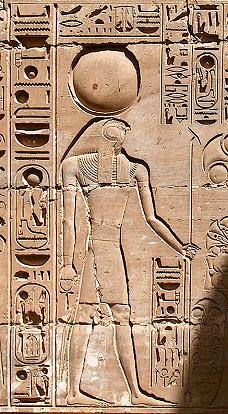
Iconographically, Khonsu was sometimes depicted wearing a headdress comprising of the lunar crescent, containing within it a circular disk, which has been interpreted as the “full moon disk”. He was, therefore, believed to be a lunar god. Interestingly, a very similar symbol is widely used within the Hindu-Buddhist tradition, and is often depicted at the top of the spire of Hindu temples as well as Tibetan stupas. Here, the circle within the lunar crescent is regarded as the “vase containing the Nectar of Immortality” (amrta-kalasa). The moon is the custodian of the celestial ambrosia, the soma liquid, which confers health, vigour, and immortality. Located at the pinnacle of the cosmos, it controls the flow of these life-giving and regenerating “waters of life” (rasa) into the world, which vitalizes everything, from the sap of plants to the blood of all living beings, and “nourishes and satisfies the gods, ancestors, men, and trees”.
As noted earlier, all of these adjectives are equally applicable to both Khonsu and Balarama, for they were both regarded as gods of fertility, abundance and virility. In addition, Balarama was also a descendant of the lunar dynasty. One may, therefore, conclude that this symbol had the same meaning in ancient Egypt as in the Hindu-Buddhist tradition; and Khonsu’s headdress conveyed some of his most important lunar attributes, as the controller of the celestial “waters of life”.
Khonsu was also shown with the regalia of a pharaoh, holding the uas scepter, and the crook and the flail. At Karnak he is usually represented as a divine child, which was indicated by the sidelock of youth (long hair arranged on either side of the head). Thus, the representation of Khonsu as a “pharaoh of divine birth” is aligned with what we know about Hercules and Balarama – they were both kings as well as kingmakers, had a divine birth, and ascended to the realms of the gods after their death.
As the pharaoh, Khonsu also wears the Uraeus crown. The Uraeus is a rearing cobra, which was a symbol of royalty and divine authority throughout dynastic Egypt. It was believed that the Uraeus protected the pharaoh by spitting fire on his enemies. The Uraeus could depict a single serpent, a double serpent (double uraeus), or even three upright serpent heads (triple uraeus). How closely this resembles the iconography of Balarama! Balarama was believed to be an incarnation of the cosmic serpent Ananta-Sesha, and was nearly always depicted with a serpent canopy over his head (usually a three, five or seven hooded serpent). In some depictions, Balarama is shown with a single rearing serpent on his head, which closely resembles the Uraeus crown.

Another interesting correlation can be found at Karnak. On one of the walls at Karnak, a cosmogony is depicted in which Khonsu is described as the “Great Snake who fertilizes the Cosmic Egg in the creation of the world”. This is closely aligned with Balarama’s representation as an incarnation of the cosmic serpent Ananta-Sesha, on whose coils the Creator Vishnu rests in the middle of the cosmic ocean. Along with Vishnu, Ananta-Sesha is also considered as an important agent of creation.
These symbolic correlations between Khonsu and Balarama indicate that Khonsu does, indeed, share many attributes with Balarama, as stated by Arrian. The association between Khonsu and Balarama is also very significant from another perspective. It validates a hypothesis that I had proposed earlier – that the Theban triad of deities is equivalent to the triad of divinities worshipped at the Jagannath Temple at Puri, India – and there must have been a transfer of this pantheon of deities from India to Egypt sometime prior to the beginning of the New Kingdom in c.1550 BC.
The Theban and the Puri triad
There are many similarities between Amun and Krishna. They are both blue-complexioned, having a couple of feathers in their headdress, and a sacred river (Nile/Ganges respectively) emerges from their toes. While the hymns of the Coffin Texts associate Amun with the falcon-headed god Horus, in Hindu myths Krishna’s vahana i.e. carrier is the eagle-headed deity Garuda. Even metaphysically they are very similar. Amun and Krishna share many epithets: they are “hidden” and “unknowable”; the “Supreme Creator” from whom the gods, humans and everything else proceeded; the “Indwelling Soul” of all creatures who “abides in everything”; the “compassionate friend” of the “poor and the wretched” etc.
The similarities between the Opet festival and the Jagannath Rathyatra are also very striking. In the Opet festival the idols of the Theban triad – Amun, Khonsu and Mut – were carried in sacred barques from Karnak to Luxor, in a splendid joyous procession down the Avenue of the Sphinxes, along the 2 mile road that connects the temples of Karnak and Luxor. The idols rested in Luxor for a period of 11 days (later extended to 24 or 27 days), and then returned back to Karnak in another joyous procession along the Nile. In the Rathayatra festival the idols of Krishna, Balarama and Subhadra are carried in three magnificent chariots pulled by thousands of devotees along the 2 km (1.5 mile) road that connects the Jagannath Temple to the Gundicha Temple. The idols rest in the Gundicha Temple for a period of 7 days, after which they return back to the Jagannath Temple, in another joyous, noisy procession known as the Ulta-Rath. The entire celebration, starting from the day of Jagannath’s bathing ceremony, till his return from the Gundicha Temple, lasts for 25-26 days, nearly the same as the Opet festival of Karnak. I have discussed these correlations in a lot more detail in my previous articles.
Now, through an entirely different line of investigation, we can see that Khonsu and Balarama are the same personality. This means that we can be quite certain that Amun-Khonsu-Mut of Thebes is the same as Krishna-Balarama-Subhadra of India. I had also proposed the hypothesis that the worship of this triad of divinities was carried into Ethiopia by the migrating Kushite tribes from the Indus Valley, after the Indus Valley civilization had collapsed around 1900 BC; and from Ethiopia the worship of Amun-Khonsu-Mut was carried into Egypt by the victorious pharaohs of the 18th dynasty in c.1550 BC. The Kushites of the Indus Valley had also migrated eastwards, towards the Gangetic plains and Peninsular India, and had instituted the worship of this triad of deities at Puri, on the eastern coast of India. This explanation is consistent with the historical and archaeological information of that period, and deserves further attention from historians.
Author:Bibhu Dev Misra
Image Courtesy: Thoughtco
You may also like
-
India Can’t Afford to Remain Stagnant at this Juncture, Says PM Modi; Asks People to Buy Locally-Made Goods
-
Stolen Artefacts to be Returned to India from Scotland Museums
-
Legendary Singer Lata Mangeshkar Passes Away At the Age of 92
-
Netaji’s Hologram Statue at India Gate
-
10th Century Stone Idol of Goat Head Yogini IllegallyRemoved from A Temple in Lokhari, Banda, UP Being Returned to India
